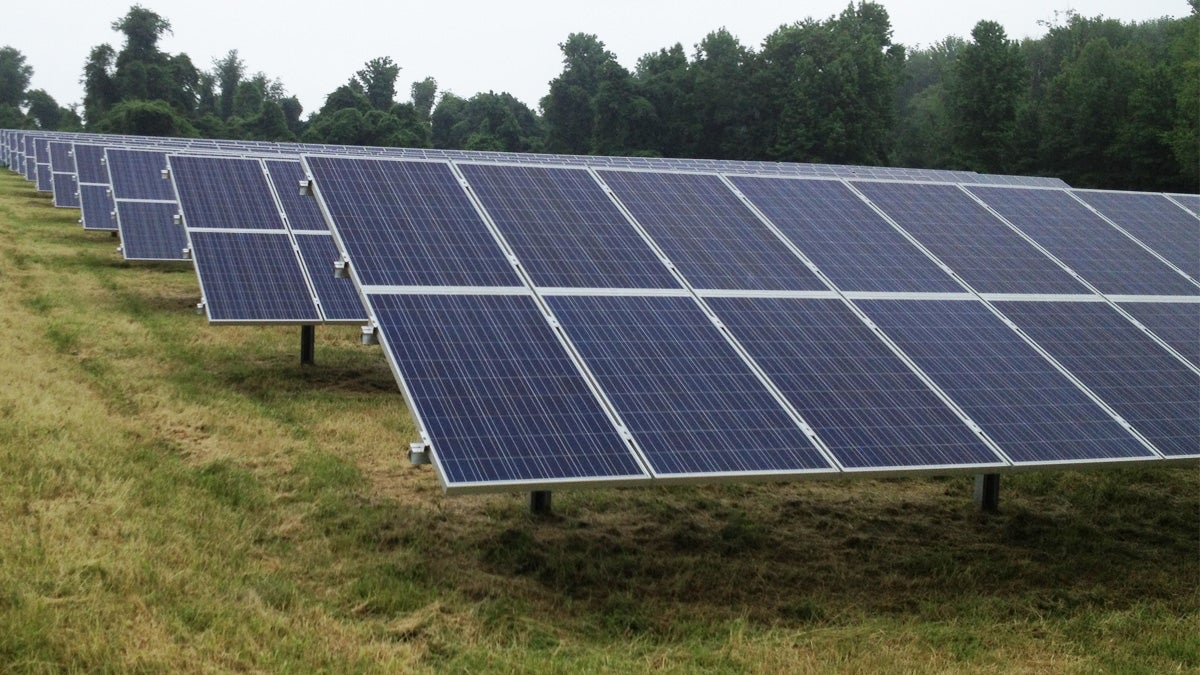Delaware’s race for the sun can be costly too

Delaware’s push into a more competitive solar business is the subject of this essayworks from Doug Rainey, editor of the Delaware Business Daily.
In the past year or so, businesspeople and government leaders in Delaware have been attending groundbreakings and ribbon cuttings for new solar energy projects.
Thanks to the focus on the sun, the state ranks seventh in the nation with 69 solar watts per capita, according to a recent report from Environmental America.
The ranking should come as no surprise. The state has a mandate calling for renewable energy sources to make up 25 percent of the state’s power mix by 2025. A separate provision calls for solar to make up 3.5 percent of the power mix.
The 3.5 percent requirement is resulting in big arrays of solar panels sprouting up in fields from Milford to Delaware City. As impressive as these arrays appear, solar has its limitations, since the sun does not shine all the time and power has to be on around the clock.
Solar is also more expensive, although the cost gap has been reduced as the cost of solar cells declines and efficiency improves. Wind power is also part of the mix, although utilities have to buy that source of power from out of state.
As Delaware Electric Cooperative General Manager Bill Andrew told Newsworks’ Mark Eichmann in a recent interview on First that electric power has to be available at an affordable cost to cover the variations of solar generation.
At present, that process includes natural-gas powered Bloom Energy fuel cells, which operate around the clock, but cost much more to operate than base load power plants. Delmarva Power customers end up paying and an additional $1.30 or so a month.
The Bloom cells are also a reflection of the fact that Delaware now has access to an abundant supply of natural gas. That fuel is rapidly replacing coal as the power source of choice.
In a relatively short period of times, the number of coal-fired units in the state will have dropped from 10 to one by the end of the year. In general, natural gas releases about half as much as carbon dioxide as coal and does not contain nasty pollutants such as mercury.
The source of the gas is the Marcellus Shale formations in Pennsylvania that have been unlocked with the use of hydraulic fracturing or fracking.
The latest power plant to ditch coal was the steam and power plant site in Dover. Owner NRG spent $25 million to convert the plant from coal to a combined cycle natural gas plant.
At the end of 2013, another coal unit at the NRG Indian River Power Plant near Millsboro will shut down, leaving the Sussex County generation station with one coal unit. That unit will be one of the cleanest in the nation, thanks to more than $300 million in scrubbing technology.
More gas-fired generation is slated to come on line when Calpine completes a natural gas-fired plant in Dover. Old Dominion, the wholesale electric cooperative that supplies Delaware Electric is moving ahead with a base load gas-fired plant in Cecil County, a short drive from the Delaware line.
It all seems to add up to a rosy outlook – except for one thing.
Based on Energy Information Administration data, Delaware ranks as the 13th highest priced state when it comes to electricity costs. That ranking automatically leads some current and potential employers to refrain from investing in the state.
Some of this cost disadvantage comes from geography. Delaware does not have dams with hydroelectric plants or coal mines. A look at the map shows nearly all states in the region with high electricity costs.
The Caesar Rodney Institute think tank pins part of the blame on the region’s liberal leanings and a large number of Democratic governors. That’s a political statement more than a science-based finding.
But as the state undergoes a painfully slow economic recovery, an argument can be made for reexamining the state’s energy strategy. After all, Delaware has room for flexibility, given the dramatic reductions in power plant emissions.
The problem is that positions are entrenched, due to the controversy over climate change. Some see the stalemate as something akin to religious extremism with zealots on both sides shouting over one another.
In Delaware, those pushing for mandated alternate energy standards dominate the discussion. But the alliance is an uncomfortable one. On one side are those who believe minerals should be left in the ground. On the other is the administration of Gov. Jack Markell who pushed for the reopening of the Delaware City Refinery, a move that saved at least a couple of thousand jobs. In return, the administration maintained strong support for retaining and even expanding energy mandates.
A similar split exists among those pushing for some changes in mandates. Many acknowledge climate change is a problem. Others see no problem at all and trot out obscure findings and take note of every cold day in the winter as evidence of a massive climate change conspiracy.
As Gov. Jack Markell heads into the final stretch of his last term, it would be an act of bravery to put the issue of alternative energy mandates on the table.
The goal would not be to abandon the progress made to date, but to somehow come up with a middle ground that would allow some relief or at least stability when it comes to electric rates.
Complicating the issue further is the pressure felt by Delmarva Power to improve its aging utility infrastructure and build a system that can better withstand increasingly harsh bouts of bad weather. Those efforts are leading to a continuous round of rate increase requests that blunt the effects of stable or lower energy prices.
Finding a middle ground won’t be easy. Delaware needs to continue to encourage residential users and small businesses to add solar panels, while reducing the risk of massive projects squeezing small players out of the solar credit market.
Granted, Markell’s already vocal detractors on the fringe would be livid. But in the battle for jobs in a global economy, a small state has to look for ways to remain competitive.
Doug Rainey is the editor of the Delaware Business Daily. Email Doug drainey@delawarebusinessdaily.com or follow him on twitter: https://twitter.com/DougRaineyDe
WHYY is your source for fact-based, in-depth journalism and information. As a nonprofit organization, we rely on financial support from readers like you. Please give today.

